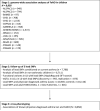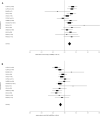Fraction of exhaled nitric oxide values in childhood are associated with 17q11.2-q12 and 17q12-q21 variants
- PMID: 24315451
- PMCID: PMC4334587
- DOI: 10.1016/j.jaci.2013.08.053
Fraction of exhaled nitric oxide values in childhood are associated with 17q11.2-q12 and 17q12-q21 variants
Abstract
Background: The fraction of exhaled nitric oxide (Feno) value is a biomarker of eosinophilic airway inflammation and is associated with childhood asthma. Identification of common genetic variants associated with childhood Feno values might help to define biological mechanisms related to specific asthma phenotypes.
Objective: We sought to identify the genetic variants associated with childhood Feno values and their relation with asthma.
Methods: Feno values were measured in children age 5 to 15 years. In 14 genome-wide association studies (N = 8,858), we examined the associations of approximately 2.5 million single nucleotide polymorphisms (SNPs) with Feno values. Subsequently, we assessed whether significant SNPs were expression quantitative trait loci in genome-wide expression data sets of lymphoblastoid cell lines (n = 1,830) and were related to asthma in a previously published genome-wide association data set (cases, n = 10,365; control subjects: n = 16,110).
Results: We identified 3 SNPs associated with Feno values: rs3751972 in LYR motif containing 9 (LYRM9; P = 1.97 × 10(-10)) and rs944722 in inducible nitric oxide synthase 2 (NOS2; P = 1.28 × 10(-9)), both of which are located at 17q11.2-q12, and rs8069176 near gasdermin B (GSDMB; P = 1.88 × 10(-8)) at 17q12-q21. We found a cis expression quantitative trait locus for the transcript soluble galactoside-binding lectin 9 (LGALS9) that is in linkage disequilibrium with rs944722. rs8069176 was associated with GSDMB and ORM1-like 3 (ORMDL3) expression. rs8069176 at 17q12-q21, but not rs3751972 and rs944722 at 17q11.2-q12, were associated with physician-diagnosed asthma.
Conclusion: This study identified 3 variants associated with Feno values, explaining 0.95% of the variance. Identification of functional SNPs and haplotypes in these regions might provide novel insight into the regulation of Feno values. This study highlights that both shared and distinct genetic factors affect Feno values and childhood asthma.
Keywords: Airway inflammation; asthma phenotypes; biomarker; genetics; genome-wide association study.
Copyright © 2013 American Academy of Allergy, Asthma & Immunology. Published by Mosby, Inc. All rights reserved.
Figures




References
-
- Vercelli D. Discovering susceptibility genes for asthma and allergy. Nat Rev Immunol. 2008;8:169–82. - PubMed
-
- A plea to abandon asthma as a disease concept. Lancet. 2006;368:705. - PubMed
-
- Anderson GP. Endotyping asthma: new insights into key pathogenic mechanisms in a complex, heterogeneous disease. Lancet. 2008;372:1107–19. - PubMed
-
- Moffatt MF, Kabesch M, Liang L, Dixon AL, Strachan D, Heath S, et al. Genetic variants regulating ORMDL3 expression contribute to the risk of childhood asthma. Nature. 2007;448:470–3. - PubMed
Publication types
MeSH terms
Substances
Grants and funding
- P30 ES007048/ES/NIEHS NIH HHS/United States
- R01 HL076647/HL/NHLBI NIH HHS/United States
- P01 ES009581/ES/NIEHS NIH HHS/United States
- R01 HL061768/HL/NHLBI NIH HHS/United States
- K22 ES022987/ES/NIEHS NIH HHS/United States
- MC_UU_12013/1/MRC_/Medical Research Council/United Kingdom
- MC_UU_12013/4/MRC_/Medical Research Council/United Kingdom
- R01 ES023262/ES/NIEHS NIH HHS/United States
- WT083431MA/WT_/Wellcome Trust/United Kingdom
- UL1 TR000430/TR/NCATS NIH HHS/United States
- R01 ES021801/ES/NIEHS NIH HHS/United States
- MC_UU_12013/3/MRC_/Medical Research Council/United Kingdom
- G1000758/MRC_/Medical Research Council/United Kingdom
- MR/K002449/1/MRC_/Medical Research Council/United Kingdom
- MR/J012165/1/MRC_/Medical Research Council/United Kingdom
- R01 HL085197/HL/NHLBI NIH HHS/United States
- G0601361/MRC_/Medical Research Council/United Kingdom
- 102215/WT_/Wellcome Trust/United Kingdom
- 097117/WT_/Wellcome Trust/United Kingdom
- P01 ES011627/ES/NIEHS NIH HHS/United States
- MC_PC_15018/MRC_/Medical Research Council/United Kingdom
- G9815508/MRC_/Medical Research Council/United Kingdom
- G0600705/MRC_/Medical Research Council/United Kingdom
LinkOut - more resources
Full Text Sources
Other Literature Sources
Medical
Molecular Biology Databases
Research Materials
Miscellaneous

